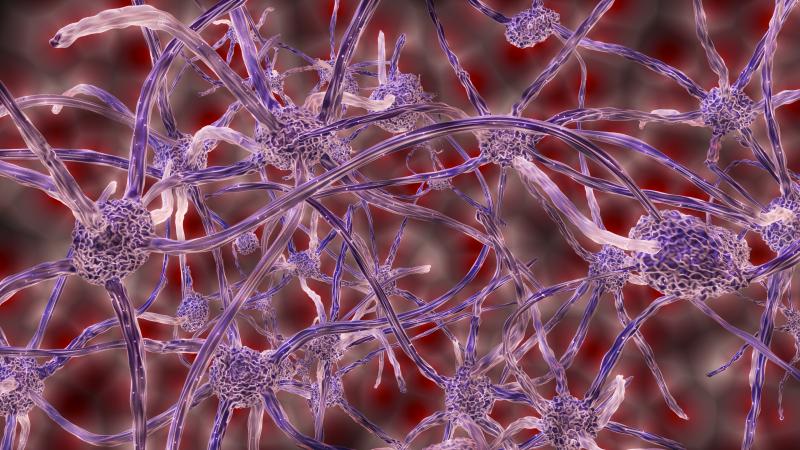
Image by MasterTux from Pixabay
The brain is the most complex thing in the universe! It is made up of an intricate network of cells called neurons. Neurons are long, elongated, fibre-like cells, and billions of them form a complex network of connections called synapses. Neurons are not physically connected, but they transmit messages between them electrochemically as non-contact nerve impulses. And, there are trillions of such connections in our brain. However, in the initial stages, when the embryo is developing, the primitive neurons are rounded and lack connection to each other.
So how do these innocuous-looking rounded cells become highly connected elongated neurons? Researchers from Manipal Institute of Regenerative Medicine, Bengaluru, found the key gene that assists in making this happen. The study published in iScience journal shows that a gene called Superoxide dismutase 2 (SOD2), hitherto known to be involved in another function, is caught performing a completely different function -- promoting the generation of neurons. The authors state that although a complete understanding of the exact mechanism of how this happens remains to be unravelled, there is a possibility that one day, human nerve cells could be grown from any human tissue cells, thereby opening therapeutic avenues for patients with nerve or spinal cord injuries.
Existing literature indicates that SOD2 basically mops oxygen radicals inside the cell. During normal metabolism, cell components called mitochondria generate energy-rich molecules from carbon sources. However, the process produces an undesirable byproduct called oxygen radicals. These are oxygen molecules with an extra electron on them which makes them highly reactive with other molecules, thereby causing toxicity in the cells. The usually designated job of the SOD2 gene is to minimise this damage by mopping up these free oxygen radicals. The researchers found that the ‘SOD2 mop’ had another function: to help the cells become neural precursors, which in turn become highly connected neurons. The process is termed ‘Differentiation’.
Scientists differentiate a neuron cell from an embryonic cell by its shape and by looking for specific proteins produced only in these neuronal cells. These proteins are ‘markers’ for that particular cell type.
To decipher SOD2’s role in the differentiation process, the researchers introduced copies of the SOD2 gene into mouse embryonic stem cells grown in the lab (cultured cells). When they increased the number of copies of the gene, the embryonic cells changed into a neuron-like appearance and exhibited ‘markers’ unique to cells of neurons. However, the markers were absent when they eliminated the SOD2 gene.
“In our study, using embryonic cells, we show that when SOD2 is knocked down or eliminated and subjected to differentiation, the embryonic cells could not specifically change into a neuron. However, this did not compromise the differentiation to other tissues,” says Dr Anujith Kumar, corresponding author of the paper.
Owing to numerous ethical problems associated with procuring human embryonic cells, the researchers used fibroblasts or skin cells of mice and intended to convert them into stem cells that mimic embryonic cells. They achieved this by introducing another gene called OCT4 into the fibroblast cells. When the researchers transferred the SOD2 gene and OCT4, fibroblasts stopped being fibroblasts and changed into neurons, but not pluripotent stem cells. (Pluripotent stem cells are master cells that can differentiate into almost any tissue cell type).
So how does SOD2 actually do this? The researchers hypothesised that SOD2 could be having other functions that involved mitochondria. However, they had to first observe the microscopic mitochondria inside the cell to test their hypothesis. To do so, they tagged a protein found on the mitochondrial surface with a fluorescent dye. Under a fluorescent microscope, these tagged mitochondria appear fluorescent. When the SOD2 gene was introduced in the cell, they could see that the mitochondria were longer than they would be. This is because the individual mitochondria had fused to produce longer filament like mitochondria.
Mitochondria fuse because of a protein called MFN2. Researchers found that the expression of SOD2 was causing the overproduction of MFN2 protein. The fusing of mitochondria was somehow related to the embryonic cells elongating and growing into neurons. But how exactly that happens is still a mystery.
“Mechanistically, it is unclear how mitochondrial fusion and fission favour commitment to neuron formation,” says Dr Kumar. However, he speculates that “As neurons are dynamic cells and dependent on excessive energy molecule ATP (adenosine tri-phosphate), probably mitochondrial fusion favours the energy supply and in turn facilitates neural formation.”
The research done on mouse cells needs to be repeated with human cells, and hopefully, the results will one day be helpful to treat nerve injuries. At this juncture, the current findings on differentiated neurons thus produced are suitable for research purposes to study neuronal development. It could also be used to develop an experimental framework to model diseases in the cells by growing them in the lab. Such experiments could be utilised for drug screening and also where researchers test the effect of promising drugs by trying them on these cells.
This article has been run past the researchers, whose work is covered, to ensure accuracy.






